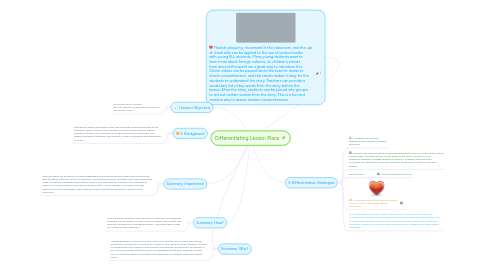Differentiating Lesson Plans
por Katherine Taylor


1. Flexible grouping, movement in the classroom, and the use of visual aids can be applied to the use of picture books with young ELL students. Many young students want to learn more about foreign cultures, so children's stories from around the world are a great way to introduce this. Online videos can be paused when the teacher needs to check comprehension, and the visuals makes it easy for the students to understand the story. Teachers can provide a vocabulary list of key words from the story before the lesson. After the story, students can be placed into groups to act out certain scenes from the story. This is a fun and creative way to assess student comprehension.
2. 1.Lesson Objective
2.1. To be able to do a simple self-introduction in English, focusing on the phrase "I like..."
3. 2. Background
3.1. Elementary school 5th grade is the first year that students officially study English in Japan. Some of the students may have taken English classes outside of school, but in general all of the students are beginners. The biggest difference between the students is their confidence and willingness to learn.
4. Summary: Importance
4.1. It will be easier for teachers to create engaging and innovative lessons when they understand their students interests, levels of readiness, and learning profiles. Students learn best when they make connections between their school lessons and their diverse interests and experiences. There is no such thing as a one size fits all education - every student is different, and this diversity must be celebrated. Every student brings something special and unique to the classroom.
5. Summary: How?
5.1. To learn about students' learning profiles, interest, and readiness teachers can do weekly surveys asking students about what they liked and disliked from the weeks lessons, and what they usually do outside of the classroom.
6. Summary: Why?
6.1. Flexible grouping, movement in the classroom, and the use of visual aids during instruction is important for young ELL learners. Grouping students together to work on assignments will create a more positive and friendly environment; movement in the classroom keeps students active and engaged during their learning; and the use of visual aids helps to facilitate understanding for students with low English levels.
7. 3. Differentiation Strategies
7.1. 1. Strategy for shy/low readiness level students: Flexible grouping
7.2. Students will feel less nervous and pressured when placed in a group for certain assignments. Teachers should create groups that have a mixture of low readiness students and high readiness students. Students who are more confident can help their classmates with the assignment so that no one falls behind.
7.3. Small groups
7.3.1. More personalized learning
